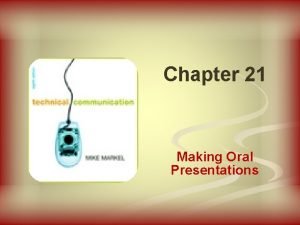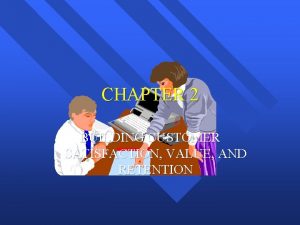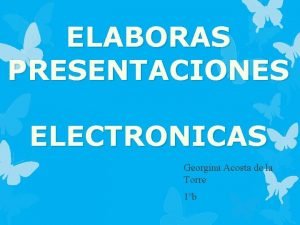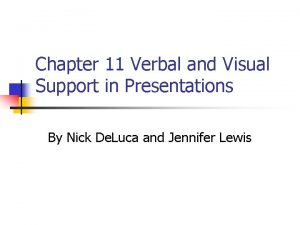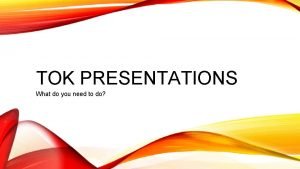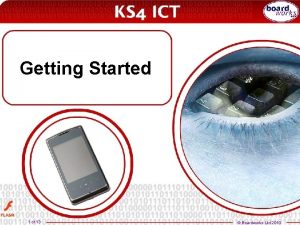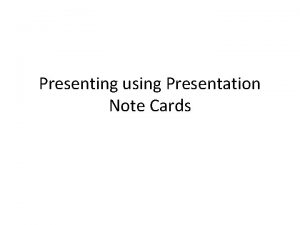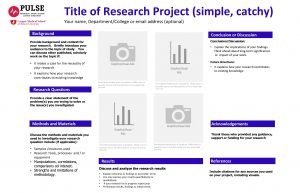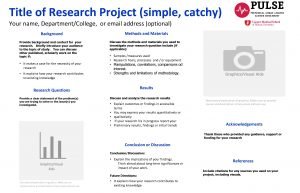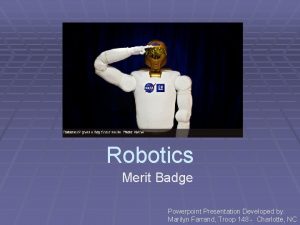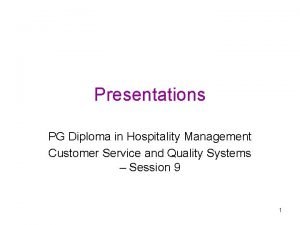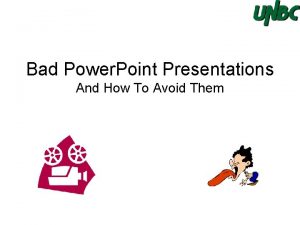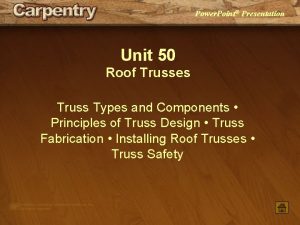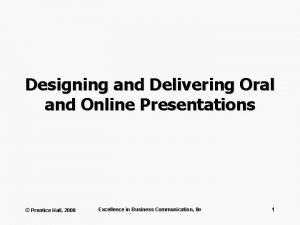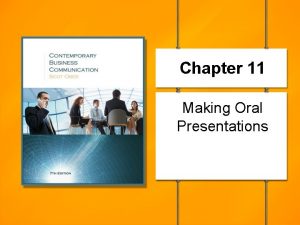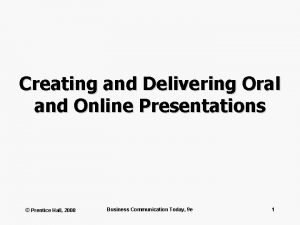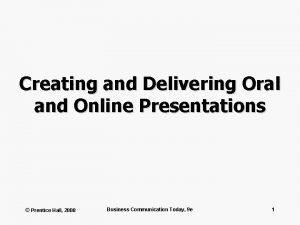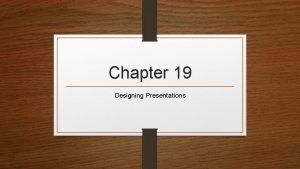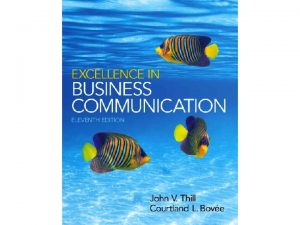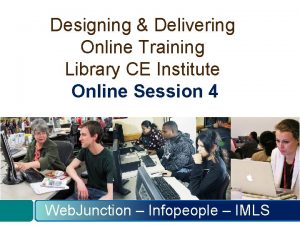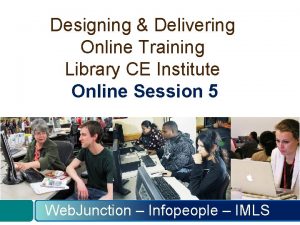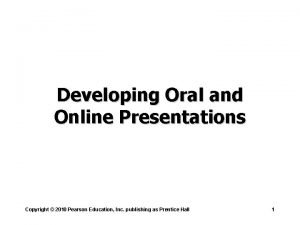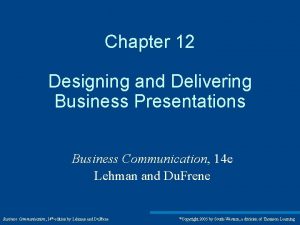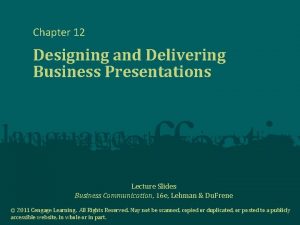Designing and Delivering Oral and Online Presentations Copyright


































- Slides: 34

Designing and Delivering Oral and Online Presentations Copyright © 2011 Pearson Education, Inc. publishing as Prentice Hall 1

Learning Objectives • Learn how to plan an oral presentation • Explain how to adapt to your audience, compose your presentation, and craft an effective introduction • Explain how to connect ideas and hold the audience’s attention during the body of a presentation and how to close effectively Copyright © 2011 Pearson Education, Inc. publishing as Prentice Hall 2

Learning Objectives • Outline the key steps in creating powerful presentation visuals • Identify the tasks needed to complete your presentation materials • Learn how to excel at presentation delivery by overcoming anxiety, handling questions, and giving presentations online Copyright © 2011 Pearson Education, Inc. publishing as Prentice Hall 3

Building Your Career with Oral Presentations • Display your skills • Think on your feet • Grasp complex issues • Handle challenges Copyright © 2011 Pearson Education, Inc. publishing as Prentice Hall 4

The Three-Step Process • Planning • Writing • Completing Copyright © 2011 Pearson Education, Inc. publishing as Prentice Hall 5

Planning Presentations • Analyze the situation • Gather the information • Select the medium • Organize the information Copyright © 2011 Pearson Education, Inc. publishing as Prentice Hall 6

Analyzing the Situation • Purpose • Audience – Information – Emotions – Persuasion – Language – Collaboration – Circumstances Copyright © 2011 Pearson Education, Inc. publishing as Prentice Hall 7

Selecting the Medium • In-person presentations • Web-based presentations Copyright © 2011 Pearson Education, Inc. publishing as Prentice Hall 8

Organizing Presentations • Define the main idea • Limit the scope • Choose the approach Copyright © 2011 Pearson Education, Inc. publishing as Prentice Hall 9

Preparing the Outline I. State purpose and main idea II. Group major points and subpoints III. List introduction, body, and close IV. Show your transitions V. Present bibliography of sources VI. Choose a compelling title Copyright © 2011 Pearson Education, Inc. publishing as Prentice Hall 10

The Speaking Outline • Follow the planning outline • Condense points and transitions to keywords • Add delivery cues • Arrange your notes Copyright © 2011 Pearson Education, Inc. publishing as Prentice Hall 11

Developing Presentations • Adapting to the audience • Composing the presentation Copyright © 2011 Pearson Education, Inc. publishing as Prentice Hall 12

Adapting to Audiences • Small groups – Casual style, promote participation, use simple visuals • Large groups – Formal style, control participation, use multimedia Copyright © 2011 Pearson Education, Inc. publishing as Prentice Hall 13

Composing Presentations • The introduction – Arouse interest – Build credibility – Preview message Copyright © 2011 Pearson Education, Inc. publishing as Prentice Hall 14

Composing Presentations • The body – Discuss ideas – Connect ideas – Capture attention Copyright © 2011 Pearson Education, Inc. publishing as Prentice Hall 15

Composing Presentations • The conclusion – Restate main points – Describe next steps – Finish strong Copyright © 2011 Pearson Education, Inc. publishing as Prentice Hall 16

Enhancing Presentations • Accurate visuals • Simple visuals Copyright © 2011 Pearson Education, Inc. publishing as Prentice Hall 17

Choosing Slide Style • Structured or Free-form slides – Elements of design – Amount of content – Number of slides Copyright © 2011 Pearson Education, Inc. publishing as Prentice Hall 18

Using Structured Slides • Advantages – Fast and easy creation – Complex data and ideas – Routine presentations Copyright © 2011 Pearson Education, Inc. publishing as Prentice Hall 19

Using Free-Form Slides • Advantages – Complement information – Manage information – Process information Copyright © 2011 Pearson Education, Inc. publishing as Prentice Hall 20

Writing Readable Content • Highlight key points • Summarize and preview message • Signal major shifts in thought • Illustrate ideas and concepts • Create interest in the message Copyright © 2011 Pearson Education, Inc. publishing as Prentice Hall 21

Modifying Slide Graphics • Reduce the level of detail • Use graphical elements Copyright © 2011 Pearson Education, Inc. publishing as Prentice Hall 22

Selecting Design Elements • Color schemes • Background artwork • Foreground artwork • Fonts and type styles Copyright © 2011 Pearson Education, Inc. publishing as Prentice Hall 23

Animation and Multimedia • Transitions • Builds • Hyperlinks • Audio or video Copyright © 2011 Pearson Education, Inc. publishing as Prentice Hall 24

Completing Presentations • Check slides • Test equipment • Practice speech • Create handouts Copyright © 2011 Pearson Education, Inc. publishing as Prentice Hall 25

Navigation and Support • Title slides • Agenda slides • Navigation slides Copyright © 2011 Pearson Education, Inc. publishing as Prentice Hall 26

Preparing to Speak • Memorizing • Reading • Impromptu speaking • Speaking from notes Copyright © 2011 Pearson Education, Inc. publishing as Prentice Hall 27

Practicing Your Delivery • Present naturally • Check equipment • Track your time • Speak clearly • Introduce slides • Plan for questions Copyright © 2011 Pearson Education, Inc. publishing as Prentice Hall 28

Delivering the Presentation • Overcoming anxiety • Responding to questions Copyright © 2011 Pearson Education, Inc. publishing as Prentice Hall 29

Overcoming Anxiety • Practice for success • Prepare more material than necessary • Think positively • Visualize your success • Take a few deep breaths • Be ready Copyright © 2011 Pearson Education, Inc. publishing as Prentice Hall 30

Overcoming Anxiety • Do not panic • Be comfortable • Focus on your message • Focus on your audience • Maintain eye contact • Keep on going Copyright © 2011 Pearson Education, Inc. publishing as Prentice Hall 31

Responding to Questions • Set ground rules • Be prepared • Note nonverbal cues • Give honest answers • Maintain control • End the presentation Copyright © 2011 Pearson Education, Inc. publishing as Prentice Hall 32

Presenting Online • Advantages – Cost savings – Convenience • Disadvantages – “Digital Divide” – “Human Moments” Copyright © 2011 Pearson Education, Inc. publishing as Prentice Hall 33

Online Presentations • Offer preview materials • Keep things simple • Seek feedback often • Consider the audience • Ensure compatibility • Allow connection time Copyright © 2011 Pearson Education, Inc. publishing as Prentice Hall 34
 Developing oral and online presentation
Developing oral and online presentation Types of oral presentations
Types of oral presentations Building customer satisfaction value and retention
Building customer satisfaction value and retention Best and worst powerpoint presentations
Best and worst powerpoint presentations Worst us presentation ever
Worst us presentation ever Organizing and delivering a manuscript speech
Organizing and delivering a manuscript speech Entertainment speech outline
Entertainment speech outline Craft of scientific presentations
Craft of scientific presentations Titles for mental health presentations
Titles for mental health presentations Advantages of multimedia presentation
Advantages of multimedia presentation Lecture presentations for campbell biology
Lecture presentations for campbell biology Corel presentations ventajas y desventajas
Corel presentations ventajas y desventajas Verbal support examples
Verbal support examples How to make a tok presentation
How to make a tok presentation Business presentations bristol
Business presentations bristol Ria seminar system
Ria seminar system Boardworks presentations
Boardworks presentations Scqa also called the pyramid principle
Scqa also called the pyramid principle Internet presentations
Internet presentations The most dangerous game powerpoint presentations
The most dangerous game powerpoint presentations Cue cards for speech
Cue cards for speech The end pictures for presentations
The end pictures for presentations Useful phrases for presentations
Useful phrases for presentations Efficient elements mac
Efficient elements mac You exec presentation
You exec presentation Catchy titles for science projects
Catchy titles for science projects Research project title
Research project title Cooking merit badge powerpoint
Cooking merit badge powerpoint Customer service presentations
Customer service presentations Cisco stack 3750
Cisco stack 3750 Bad powerpoint presentations examples
Bad powerpoint presentations examples Really bad powerpoint presentations
Really bad powerpoint presentations Youexec
Youexec Roof ppt presentations
Roof ppt presentations Https://creativemarket.com/
Https://creativemarket.com/

